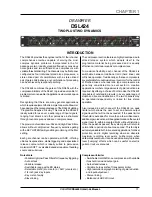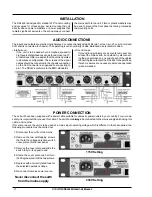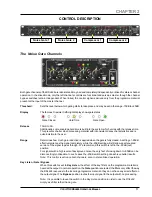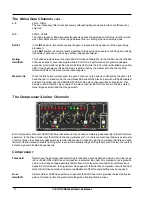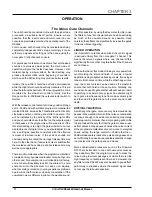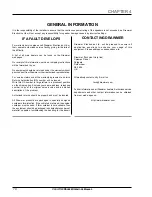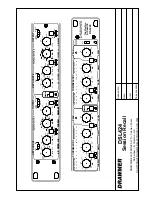
8
DRAWMER
DSL424 O
PERATOR’S
M
ANUA
L
OPERATION
The Noise Gate Channels
CHAPTER 3
The unit should be connected in-line with the signal to be
processed via suitable insert points. Ensure, where
possible, that the insert send and return level on your
console approximately matches the operating level of the
DSL424.
For mono use, each channel may be considered as being
completely independent and set up accordingly. For use
with stereo signals, all setting up is then done using the
noise gate 1 (left) channel's controls.
For percussive material such as drums, fast synthesised
sounds or percussive bass guitar, the Hard mode of
operation will give the fastest response. However, with
material having a slower attack, the Hard setting may
produce transient clicks at the beginning of sounds in
which case the Soft setting may produce better results.
Initially, the Low filter should be set fully anti-clockwise
while the High filter should be set fully clockwise. This will
allow the full audio spectrum of the input programme to be
monitored by the side-chain control circuitry. Set the
Range control to -90dB and the output selector switch to
Normal.
With the release control set at its mid-way position, Range
set to -90dB and with suitable programme material fed
into the DSL424, increase the Threshold level from its anti-
clockwise position until the gate starts to operate. This
will be indicated by the activity of the traffic light LEDs
and you should also hear the effect on the outputs signal
in that pauses in the programme will now be silent. If the
threshold setting is too high, the gate will start to cut out
wanted pieces of programme so you should adjust it to as
low a setting as possible consistent with the effective
removal of low level noise. If the ends of sounds are
obviously being truncated, then a longer release time may
help. On the other hand, if unwanted noise is audible after
the wanted sound has ended, a shorter release time may
well be more appropriate.
There are circumstances when the programme material is
corrupted not only by unwanted random noise, but by some
other sound. For example, in a multi-miked drum kit setup,
some hi-hat will inevitably leak into the snare mic, some
snare drum into the kick drum mic and so on. Equally,
when recording on location, you may experience problems
due to wind or traffic noise or close-by conversation. If the
unwanted noise is different in pitch to the wanted sound,
it is often possible, by using the Key Listen facility, to use
the filters to 'tune' into the wanted sound while excluding
as much of the unwanted sound as possible. Used
carefully, these filters can significantly increase the gate's
immunity to false triggering.
LINKED OPERATION
It is important to note that when linked, the control signal
is derived entirely from the noise gate 1 channel. This
means that stereo signals where one channel differs
significantly from another may fare better if the channels
are not linked.
On the other hand, this mode of linking is very powerful in
synchronizing the start and finish of sounds, a typical
application being to tighten up backing vocals. If one singer
tends to finish notes on time while the other hangs on too
long, the correct version can be used as the master to
ensure that both finish at the same time. Similarly, one
sound can be used to gate another without having to resort
to patching in an external key signal. An example might
be to gate a low frequency tone from a bass drum signal
and then add this gated tone to the drum sound to add
depth.
DIFFICULT MATERIAL
As with any other gate, noise can only be removed during
pauses in the wanted material. If the noise contamination
is serious enough to be evident even during moderately
loud programme material, then simple gating will do little
to help. Indeed, the very fact that the gate produces near-
perfect silence during pauses can make the noise content
of the programme material seem even worse. In marginal
cases, setting the range control to -20dB rather than -
90dB will adequately reduce the noise during pauses but
not sufficiently to cause an unacceptably dramatic change
in noise level as the gate opens and closes.
More sophisticated processors such as the Drawmer
DF330 are better able to cope with excessive noise as
they adaptively filter the programme so as to mask the
noise during low level passages or where there is little
high frequency content present to mask it. However, the
key filters in the DSL424 may also be used to good effect,
particularly in situations where the wanted signal does
not occupy the full audio spectrum.



